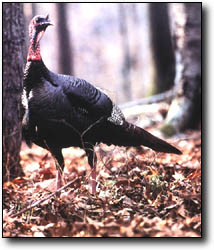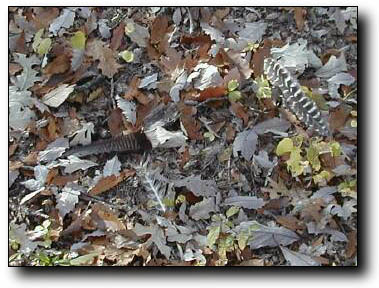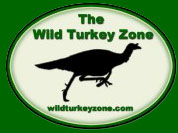Fall
Behavior
 |
|
A
Lone Gobbler in the Fall
|
After the spring breeding season is over,
the turkeys begin to break up into the sex
and age classes they will stay in through
fall and winter. Generally, you will find
three types of flocks in the fall.
The most common type of flock
will consist of one or more hens with their
poults and occasionally young gobblers hatched
the previous year (1 1/2 years old). Solitary
hens who either lost their nest or their
poults make up the second type of group.
The most sought after, but hardest to locate
groups, are the small bunches of gobblers.
These bachelor groups can consist of anywhere
from 1 to 20 or more longbeards and they
will usually consist of birds of around
the same age.
The gobblers will form family
flocks when they are young and through the
years this group gets smaller and smaller.
This often leaves a solitary gobbler which
spends all of its time alone. If you really
want a challenge, try for one of these "hermit"
gobblers. Even if they are still in small
flocks, the oldest gobblers become very
solitary after the spring season and are
extremely difficult to locate and call in.
A fourth type of flock will often show up
later in the fall or early winter. Young
jakes will often break away from the hens
to form their own gangs.
 |
|
Look
for Black and White Barred Wingfeathers
and Tail Feathers to Locate Roost
Locations In the Fall
|
In the fall, the turkeys will
also shift their home range from where they
spent the spring and summer. During the
spring and summer, turkeys rely mainly on
a diet of grasses, seeds and insects. Once
fall begins, turkeys may shift their home
range several miles or more to locate sources
for their fall diet of acorns, beechnuts,
and agricultural crops like corn, soybeans
and milo.
The timing of the shift from
the summer and early fall range to the late
fall and winter range depends a lot on the
weather that year. If your area hasn't had
a good hard freeze when your season opens
up (often the case where I hunt in Kansas),
the birds will often still be found in pastures
and grassy areas where they will still be
chasing grasshoppers and other insects and
beetles.
The one nice thing
about fall birds is they do eventually become
pretty reliable in their routines. Unlike
the spring, they will often use the same
roost site night after night and they almost
always have the same general pattern to
their movements during the day. I've patterned
flocks of turkeys in the fall and have found
them to have an almost uncanny ability to
keep to a schedule; sometimes down to the
minute.
Fall turkeys are also a lot
more vocal than birds in the spring. When
a flock of hens and poults gets worked up
in the fall they can make quite a racket.
The poults will give a kee-kee run when
they are separated from their mother and
the mother makes assembly yelps to gather
her brood back together. Listening to a
flock of turkeys in the fall sort themselves
out after coming down from the roost is
a fantastic lesson in turkey talk.
Turkeys also spend a lot of
time establishing a pecking order in the
flock during the fall which means there
is a lot of fighting going on between birds
to find out who is more dominant. This makes
fighting purrs especially effective calls
in the fall because not many turkeys will
turn down a good fight

